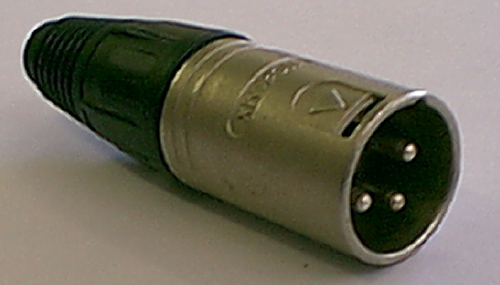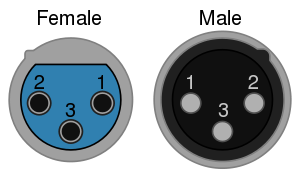Audio Cables
There are two main types of audio cable we will look at: Single core / shielded (unbalanced) and One pair / shielded (balanced).Single Core / Shielded Cable
In a single core / shielded cable, the single core is used for the +ve, or 'hot', and the shield is used for the -ve, or 'cold'.This type of cable is used for unbalanced audio signals.
 Single core / shielded cable
Single core / shielded cableOne Pair / Shielded Cable
A one pair / shielded cable has one core as the +ve, and the other core is -ve. The shield is earthed.This type of cable is used for balanced audio signals.
 One pair / shielded cable
One pair / shielded cableAudio Connectors
There are a variety of different audio connectors available. The most common types are 3-pin XLR, RCA, and 6.5mm jacks (also known as ¼" jacks).3-pin XLR
3-pin XLR connectors are mainly used for balanced audio signals. Using a balanced signal reduces the risk of inference.- Pin 1 is the earth (or shield)
- Pin 2 is the +ve (or 'hot')
- Pin 3 is the -ve (or 'cold).
| 3-pin XLR Male |  |  |
| 3-pin XLR Female |  |  |
 | |
| Pin | Function |
|---|---|
| 1 | Chassis ground (cable shield) |
| 2 | Positive polarity terminal (hot) |
| 3 | Return terminal(cold) |
¼" Jack (6.5mm Jack)
There are two types of 6.5mm Jacks: Mono and stereo. The mono jack has a tip and a sleeve, the stereo jack has ring, a tip and a sleeve.- On the mono jack the tip is the +ve, and the sleeve is the -ve or shield.
- On a stereo jack being used for a balanced signal, the tip is the +ve, the ring is the -ve, and the sleeve is the shield.
- On a stereo jack being used for a stereo signal (left and right), the tip is the left, the ring is the right, and the sleeve is the shield.
| 1/4" Mono Jack | ||
| 1/4" Stereo Jack |
RCA
RCAs are used a lot for home stereos, videos, DVDs etc.The RCA can carry either audio or video. It is wired the same way as a mono jack: The center pin is the +ve, and the outer ring is the -ve or shield.
| RCA Male |  |  |
What is Balanced Audio?
Balanced audio is a method of minimizing unwanted noise from interference in audio cables. The idea is that any interference picked up in a balanced cable is eliminated at the point where the cable plugs into a sound mixer or other equipment.Balanced audio works on the principle that two identical signals which are opposite polarities (often erroneously called "out of phase") will cancel each other out. The cables used in such systems are designed to carry two versions of the signal and manipulate the polarities of these signals to eliminate noise.
This will make more sense when we look at how balanced cables work, but first we need to take a step backwards and look at unbalanced audio cables.
| How to wire an XLR Connector (balanced) A balanced system is used in pro audio with an overall screen covering a twisted pair. Pin 2 on the XLR is 'hot' and carries the positive going signal, whilst pin 3 is 'cold' and provides the return. Any interference that penetrates the overall braided screen affects both the 'hot' and 'cold' wires simultaneously, and due to the balanced transformer or electronics at the pre-amplifier is effectively ignored as the pre-amp only amplifies the difference between 'hot' and 'cold'. The female XLR uses the same pin numbering but pins 1 and 2 are reversed . |  |
| How to wire an XLR connector (unbalanced) The unbalanced system is used for high impedance microphones over short distances, and is not recommended for professional use due to susceptability to any RF noise - such as lighting sources, taxi radios etc. Pin 1 is shorted to pin 3, at either end of the cable |  |
| How to wire a 1/4" Jack Plug The tip of the jack is 'hot' and carries the positive going signal, whilst the sleeve is 'cold' and carries the ground. To wire to an unbalanced twin core cable, connect the blue or 'cold' wire to the sleeve as well. |  |
No comments:
Post a Comment